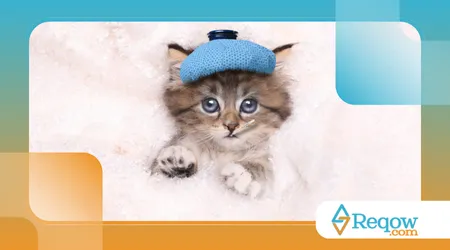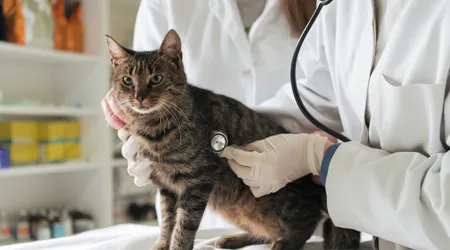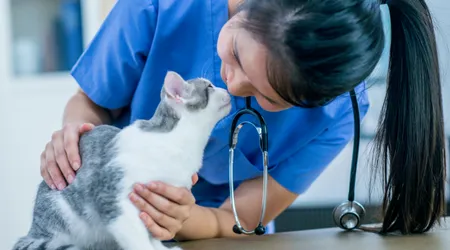Heart Disease in Cats: What You Need to Know

To the heart disease in cats are a topic that raises concern, but also curiosity among guardians, after all, who doesn't want to protect their feline?
Advertisements
These problems, often silent, can go unnoticed until it is too late, which makes knowledge essential.
Imagine your cat, that purring companion on the couch, facing something so serious without you even suspecting.
Well, their heart health deserves special attention, and it's not just about the vet, but about understanding subtle signs.
In this text, we will explore causes, symptoms, diagnoses and care, all in a clear, practical and updated way for 2025.
Advertisements
Get ready to dive into this universe, because information can be the first step in saving a furry life.
A cat's heart is a fascinating mystery, small but powerful, beating steadily to sustain jumps and play, until something goes wrong.
Unlike humans, felines hide their weaknesses as masters of deception, a legacy of their wild ancestors.
This means that you, the guardian, need to be a detective, noticing changes that seem trivial but may cry out for help.
Let's simplify this topic by providing real data, everyday examples, and even tables to organize your ideas.
The goal here is to equip you with knowledge, without technical jargon, so you can care for your cat with confidence and love.
What Are Heart Diseases in Cats?
Heart disease in cats includes conditions that affect the heart's muscle, valves, or rhythm, compromising its vital function.
The most common, called hypertrophic cardiomyopathy, thickens the heart walls, making it difficult to pump blood, a problem that requires prompt attention.
Others, such as arrhythmias or congenital defects, also appear, but less frequently, each with its own way of complicating feline life.
++ The Best Natural Treats for Dogs and Cats
Owners often think of the heart as a simple engine, but in cats it is sensitive, vulnerable to genetic factors, age, or even chronic stress.
A 2023 survey by Journal of Veterinary Internal Medicine showed that 15% of cats over 10 years old have some heart problem.
This isn't meant to scare you, but to warn you: your feline could be in the statistics without you knowing, so keep an eye out for signs.

Why Do Cats Develop These Problems?
Genetics is a frequent culprit, especially in breeds like Maine Coon and Ragdoll, which are predisposed to cardiomyopathies from birth.
But it doesn't stop there, obesity also weighs heavily, literally forcing the heart to work harder, like a car with an extra load.
Diseases such as hyperthyroidism or high blood pressure, common in older cats, enter the mix, accelerating cardiac wear.
See also: How Do I Know if My Pet Is Overweight? Weight Management Tips
External factors tell a story, imagine a cat stressed by changes in the house or lack of routine, the heart feels it.
An unbalanced diet, rich in sodium, can be another trap, accumulating risks over the years.
Each case is unique, but the secret is prevention, observing what you can control, such as diet and environment.
Signs You Can't Ignore
Cats can't talk, but their bodies give clues. Rapid breathing or panting is a classic warning sign of heart disease in cats.
Sudden weakness, as if the cat is out of breath after playing, is also a red flag, along with lethargy or disinterest in food.
These symptoms come on in secret, so pay attention to the details of your daily life.
See more: Tips for Maintaining Your Pet's Mental Health
Sometimes, the owner notices the cat coughing, something rare in felines, or lying on its side, avoiding exertion, this may indicate fluid in the lungs.
A practical example: if your cat, once agile, now hesitates to jump on the sofa, it's worth investigating.
Be alert, because these signs don't shout, they whisper, and it's up to you to listen.
How does the veterinarian diagnose?
Diagnosis begins with a stethoscope, the veterinarian listens for murmurs or strange rhythms, but this is only the first step, tests confirm the suspicion.
Echocardiogram, an ultrasound of the heart, is king here, showing wall thickness or fluid buildup with impressive accuracy.
X-rays and electrocardiograms complete the team, revealing what the eyes cannot see.
Taking your cat to the vet can be stressful, but it's crucial. Think about Maria's case, who noticed her cat panting and discovered cardiomyopathy early.
Regular checkups, especially after age 7, become a smart routine, catching the problem before it grows.
The technology of 2025 is on your side, use it without fear.
Treatments Available in 2025
Medications such as beta-blockers or diuretics help relieve the heart's pressure by controlling its rhythm and removing fluids that suffocate the lungs.
Surgeries are rare, but in severe cases, such as birth defects, they can correct the problem, requiring experienced hands and advanced clinics.
It all depends on the severity and early diagnosis.
Complementary therapies are gaining ground, diets with enhanced taurine or omega-3s are becoming allies, while stress is reduced in calm environments.
A guardian from São Paulo, for example, adjusted his elderly cat's routine and saw an improvement in his energy.
In 2025, the focus is on integrating natural remedies and care, personalizing treatment.

Prevention: The Power Is in Your Hands
Preventing heart disease in cats starts with a healthy weight, no excess food or indiscriminate treats, the heart will thank you.
Annual check-ups become a smart habit, especially for at-risk breeds or older cats, catching signs before they turn into a crisis.
Physical activity, such as playing with wands, keeps the engine running.
A balanced diet is golden, avoid high sodium and seek nutrients that protect, while stress disappears with care and routine.
Think about John, who swapped fatty snacks for light options and saw his cat become more active.
Small actions add up, transforming care into longevity for your feline.
Tables to Simplify Your Life
Here's a chart of common signs to help you identify what to look for in your cat on a daily basis.
| Symptom | What it means | Immediate Action |
|---|---|---|
| Panting | Possible fluid buildup | Consult a veterinarian |
| Weakness or lethargy | Overwhelmed heart | Observe and note |
| Rare cough | Pressure in the lungs | Urgent visit to the vet |
Now, take a look at the most prone breeds to find out if your cat is on the radar.
| Race | Risk | Extra Care |
|---|---|---|
| Maine Coon | High (cardiomyopathy) | Exams from a young age |
| Ragdoll | Moderate to high | Controlled weight |
| Persian | Moderate | Regular check-up |
The Emotional Impact on the Tutor
Finding out that your cat has a heart problem breaks your heart, and guilt and fear appear uninvited.
But know that you are not alone, online communities in 2025 exchange experiences, offering support and practical tips.
The bond with your pet becomes strength, transforming concern into action.
Dealing with treatment requires patience, giving medication or adjusting routines can be challenging, but love makes up for it.
Think about Ana, who adapted her home for her cat with heart disease and today celebrates each extra day.
It's about partnership, you take care of him, and he teaches you resilience.
Conclusion: Your Cat Depends on You
Heart disease in cats is not a death sentence, but a call for you to act, observe, prevent, and seek help when needed.
His heart, small and brave, counts on your attentive eyes and careful hands to beat for many years.
Data shows that early diagnosis increases survival, so don't underestimate the signs, they are the map to feline health.
Be the owner who makes a difference, take your cat to the vet, adjust their diet, play more, and create a happy and lively home.
In 2025, science and caring go hand in hand, and you have the power to unite the two.
Take care of your feline's heart, because he already takes care of yours every day, with every purr and knowing look.
